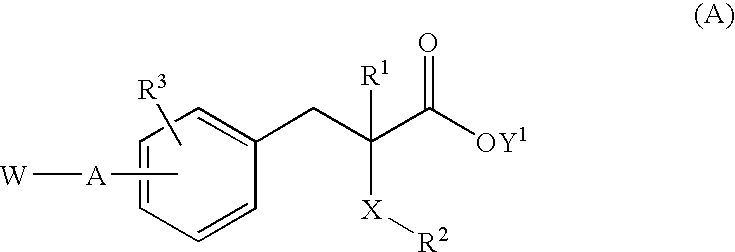Substituted phenylpropionic acid derivatives
a technology of phenylpropanoic acid and derivatives, which is applied in the direction of biocide, organic chemistry, peptide/protein ingredients, etc., can solve the problems of unstable endogenous unsaturated fatty acid derivatives, inability to be offered as medicinal drugs, and inability to meet the transcription-activating function of ppar in strength, so as to achieve high safety
- Summary
- Abstract
- Description
- Claims
- Application Information
AI Technical Summary
Benefits of technology
Problems solved by technology
Method used
Image
Examples
example 1
Ethyl 3-(3-amino-4-methoxyphenyl)-2-methoxypropanoate
[0193]
[0194]Under an argon atmosphere, stirring and cooling with ice, a solution of triethyl 2-phosphonobutyrate (5.00 g, 19.8 mmol) in anhydrous tetrahydrofuran (30 mL) was added dropwise slowly to a solution of sodium hydride (60% oil dispersion, 795 mg, 19.9 mmol) in anhydrous tetrahydrofuran (120 mL). After stirring for 1 hour at 0° C., a solution of 4-methoxy-3-nitrobenzaldehyde (3.26 g, 18.0 mmol) in anhydrous tetrahydrofuran (50 mL) was added dropwise, and the mixture was stirred for 1 hour at 0° C. and for 3 hours at room temperature. The reaction mixture was concentrated and ice water was added to the residue, which was extracted with ethyl acetate. The extracte was washed with water, brine and dried over anhydrous sodium sulfate, and then concentrated. The residue was purified by silica gel column chromatography (eluent n-hexane:ethyl acetate=8:1→2:1 v / v) to obtain 4.69 g (93%) of ethyl 2-ethyl-3-(4-methoxy-3-nitrophenyl...
examples 2 and 3
[0198]Similarly to Example 1, compounds shown in Table 1 were synthesized.
[0199]
TABLE 1MassExampleR2R3R4analysis (m / z)2C2H5OCH3C2H5251 (M+)3n-C3H7OCH3C2H5265 (M+)
example 4
Methyl 3-(4-methoxy-3-nitrophenyl)propanoate
[0200]
[0201]To 100 mL of concentrated nitric acid, cooled with ice, publicly known [e.g. Lebedev S. A. et al, J. Organo-met. Chem., 1988, 253] 4-methoxyphenylpropanoic acid (5.00 g, 25.7 mmol) was added little by little under stirring. After completion of the addition, the mixture was stirred further for 4 hours under cooling with ice. The reaction mixture was poured into ice water, which was extracted with methylene chloride. The extracte was dried over anhydrous sodium sulfate and concentrated. The residue was purified by silica gel column chromatography (eluent methylene chloride→methylene chloride:methanol=15:1 v / v) to obtain 2.70 g (44%), of the title compound as a faintly yellow oil.
[0202]1H-NMR (400 MHz, CDCl3) δ2.64 (2H, t, J=7.3 Hz), 2.95 (2H, t, J=7.3 Hz), 3.67 (3H, s), 3.94 (3H, s), 7.02 (1H, d, J=8.3 Hz), 7.39 (1H, dd, J=8.3, 2.4 Hz), 7.70 (1H, d, J=2.4 Hz).
PUM
| Property | Measurement | Unit |
|---|---|---|
| temperature | aaaaa | aaaaa |
| temperature | aaaaa | aaaaa |
| pressure | aaaaa | aaaaa |
Abstract
Description
Claims
Application Information
 Login to View More
Login to View More - R&D
- Intellectual Property
- Life Sciences
- Materials
- Tech Scout
- Unparalleled Data Quality
- Higher Quality Content
- 60% Fewer Hallucinations
Browse by: Latest US Patents, China's latest patents, Technical Efficacy Thesaurus, Application Domain, Technology Topic, Popular Technical Reports.
© 2025 PatSnap. All rights reserved.Legal|Privacy policy|Modern Slavery Act Transparency Statement|Sitemap|About US| Contact US: help@patsnap.com



